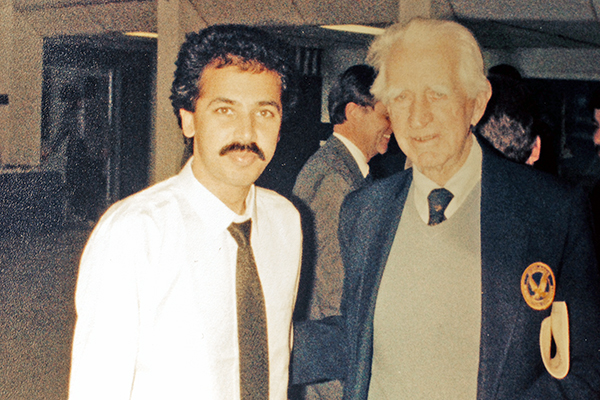Aviation fans have been waiting for more than 30 years. Now they can finally reserve their spots at viewing parties and buy advance tickets for Top Gun: Maverick, the sequel to a movie that launched countless aviation careers – and sold lots of Ray-Bans.
As a soon-to-be Ph.D. in education focused on science, technology, engineering and math, Riaz Zaidi recognizes the teachable moment. He also has a long-established passion for aviation backed up with five aeronautical science and engineering degrees from Embry-Riddle earned from 1984 to 1994. (He has earned a total of 10 degrees.) His experience and enthusiasm will come together in a talk titled Engineering the Top Gun.
As a faculty member at the University of Missouri-St. Louis, Zaidi is a featured speaker at the St. Louis Science Center. His talk is part of technology programming surrounding their OMNIMAX showing of Top Gun: Maverick, starting May 30.
“I’ve been affiliated with the university all my adult life. I helped set up the mechanical engineering program. My ultimate goal is to teach at Embry-Riddle someday,”
Riaz Zaidi
Zaidi has earned the right to append nearly the whole alphabet soup of academia to his name: B.S., B.S., MAS, MEM, M.S., M.A., M.Ed. and more. Although not a pilot, he knows his way around fighter aircraft. He joined McDonnell Douglas Aerospace in 1992 and then made the transition to The Boeing Company. He was a senior engineer for the F/A-18 program and then devoted 13 years to the F-15 program as project engineer and scientist.
He is the subject-matter expert on composites and plans to bring representative samples to show his audience. Compared to earlier aircraft, composite materials represent a significantly higher percentage of structural weight and external surface area for the real star of the new movie: the F/A-18 E/F. Thanks to these advantages, composite technology is expected to improve both the performance and life-cycle cost of the Super Hornet.
Top Gun: Maverick is the story of skilled U.S. Navy pilots who push the limits of the F/A-18 E/F Super Hornets, as well as their skills and courage. As an undergraduate in an Embry-Riddle program then called Aircraft Engineering Technology, which encompassed maintenance and engineering, Zaidi met the real deal. He was a student-assistant to fighter pilot and aeronautical engineer Kenneth Rowe.
A senior lieutenant in the Korean People’s Army Air and Anti-Air Force, Rowe flew 100 combat missions during the Korean War. He was the first pilot to defect to South Korea with an operational aircraft, his MiG-15. Rowe was granted asylum in the United States and went on to earn mechanical and electrical engineering degrees. He worked in the aviation industry and finished his career with 17 years as an aeronautical engineering professor at Embry-Riddle. Rowe retired in 2000 and is now living in Texas.
Another aviation legend who made an impression on Zaidi when they met on campus was John Paul Riddle. “He was a fascinating guy who was proud Embry-Riddle was attracting international students. He wanted to know all about my original home in Pakistan,” Zaidi remembers.
Zaidi has maintained close ties with Embry-Riddle, as the longest serving member of an industry advisory board (IAB), and by visiting the Daytona Beach Campus every year to recruit for Boeing. He hopes to return for an extended stay. “I’ve been affiliated with the university all my adult life. I helped set up the mechanical engineering program. My ultimate goal is to teach at Embry-Riddle someday,” he says.
In a letter to a friend, John Paul Riddle shared his review of the original Top Gun, noting, “It seems like it may be a hit, so maybe there will be more flying movies.” It has been a long wait for Maverick’s return, but maybe a new aviation blockbuster will outperform the original in inspiring a new generation of aviation professionals. Eagles like Riaz Zaidi will be ready to guide them through the engineering that satisfies the need for speed and keeps pilots out of the danger zone.
